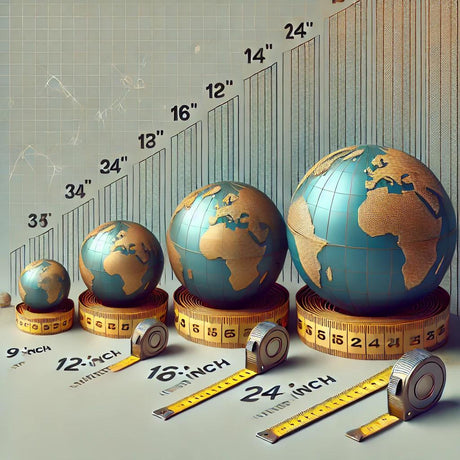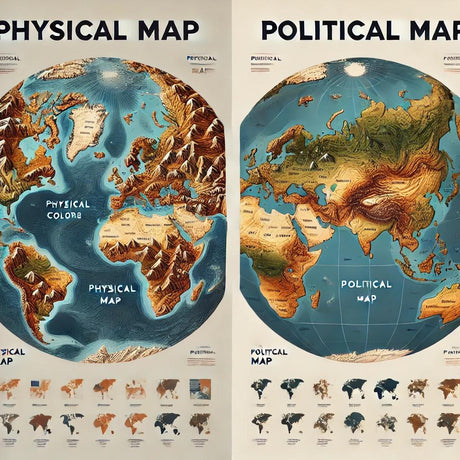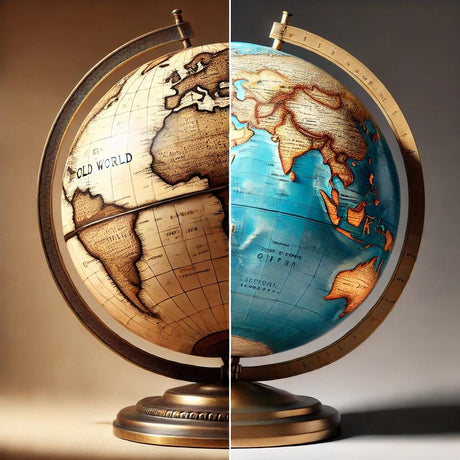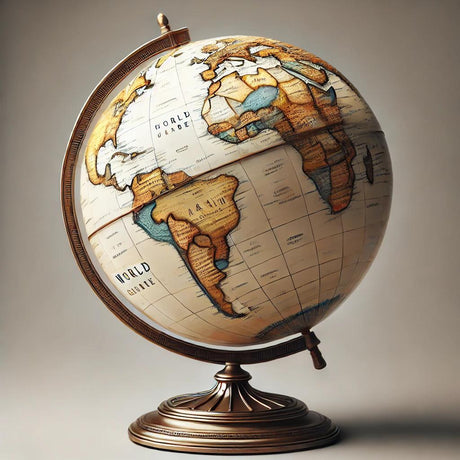Many questions may arise when you are searching for that perfect globe. Below find some of our customers' most frequently asked questions. It may help your selection process go a bit faster.
Why are globes tilted?
Most globes tilt at an angle of 23.5º to match the actual tilt of the earth in relationship to our sun. Incidentally, it is this tilting of the earth relative to the sun, rather than its changing distance from the sun, that causes the seasons to change and gives us more daylight hours at certain times of the year.
How do you find a place on a globe & How do you look up a location based on latitude and longitude?
Because a globe is round with no beginning or end, there are two imaginary reference lines from which all distances and locations are determined ‐ the equator and prime meridian. Both the equator and the prime meridian intersect at point “0”, where all numbering starts with longitude and latitude lines. Locations are uniquely identified on a globe by the point where the longitude and latitude lines intersect, i.e., Dallas, Texas, is located 33º north (latitude) 97º west (longitude).
- Equator: Runs east and west around the exact middle of the globe.
- Prime Meridian: Imaginary line running from pole to pole and passing through Greenwich, England.
- Longitude: Imaginary lines running parallel with the prime meridian through each pole and numbered in 15º increments.
- Latitude: Imaginary lines running around the globe parallel to the equator and numbered at 10º or 15º increments.
- What’s the difference between the beige/antique and blue colored globes?
Antique, beige-colored globes resemble ancient parchment, with an “Old World” appearance often preferred in-home or office settings. The geographic information is up‐to‐date, and the antique appearance is for its esthetic appeal. The blue globes have ocean areas in blue and usually consist of highly contrasting, colorful, political boundaries. The youth market often prefers the realistic appearance of these globes.
What is that little round dial at the North Pole?
It’s called a time dial and is used to compare time around the world. The time dial is available on select models.
Why do some globes have a metal meridian or semi-meridian around them?
Most globes have a metal ring, either a full circle or half (semi) circle. These rings are called meridians, and on some globe styles, they are numbered in degrees from 0º at the equator to 90º at either pole. Meridians use to help locate positions on the globe. Since most world globes have the longitude and latitude lines on the maps, the numbers on the meridian have become less important and are mainly provided for decorative appeal. The ring itself still serves to hold the globe ball in position.
For more information, see our guide on globe mounting styles.
Which place names are included on globes?
Subject to space limitations, you will find attempts to list all nations and capitals, then the biggest city in that country or state, or a famous city. There are more names on the coastline because there is room for them. If a town has some importance other than size or capital, then it’s added. The U.S. Government has a list of names for cities and countries outside North America that they call ‘conventional’ names. They are easier to understand than the literal translation and are why maps show Finland, for example, and not Suomi.
What is the raised relief feature on some globes?
Globes with raised Relief better emphasize the mountainous areas of the world. They are there so that you can see and feel the mountains, although their actual height on the globe does not have any relationship to the actual relative heights of the mountain ranges and not all mountains or mountain ranges will have this feature. Raised Relief is only available on select world globes. See the product features section of the product page to see if it’s included.
For more information see our article on What is Raised Relief.
How often are globe maps updated?
Most of our manufacturers have a policy of updating a map every time it’s printed. Although the names or boundaries of countries can change due to wars or other political upheavals, most changes are simple name changes that are relatively easy to make. Typically when the U.S. State Department — along with representatives (usually the embassies of the governments involved), recognizes the changes as being a fact, it is then included.
For more information see our article How Globes are Made: Maps.
How do you clean the globe?
Markings can be wiped off with a moistened cleansing tissue or soft, damp cloth. Household dust can be removed with a dry cloth, though you may occasionally wish to use a slightly dampened cloth to remove fingerprints or smudges. We recommended a mild, non‐abrasive product for difficult marks. Do not use industrial or household cleaners that contain alcohol or any solvent.
Can push pins be used in my reclaimed paper fiber or vinyl/plastic globe?
We do not recommend sticking any object into its globes. Doing this will damage the surface.




